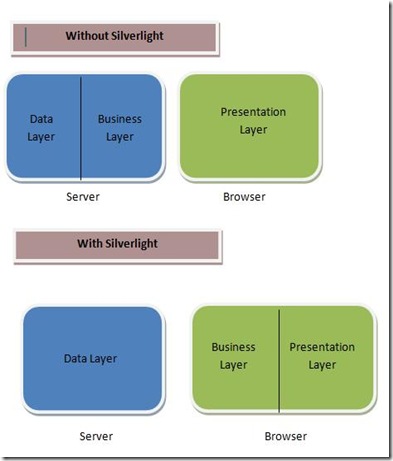Silverlight and The Application Design
Today is August 5th 2008 and I am writing this short post just to convey how Silverlight changes the overall design of a conventional browser based application. Current public version of Silverlight is 2 Beta2.
There are many reasons to use Silverlight;
- To enhance the UI of existing browser based applications; When we install Silverlight plug-in, browser can understand more set of tags (XAML) apart from HTML tags. Moreover we can use the capabilities of the presentation engine of Silverlight to draw better UI.
- To scale the application; Since now most of the end user interaction and processing will happen at client side itself, there will be less number of hits on the server. So now the application could support more number of concurrent users.
- To do things beyond JavaScript; Not many things can be done with JavaScript which can be achieved with Silverlight. one example could be rendering HD video, which requires us to use graphics card capabilities to render it.
- To use existing skill set of developers; Silverlight supports multiple languages (like C#, VB.NET, IronRuby, IronPython etc.) we could reuse the existing capabilities of developers to create better applications over web rather than learning new technologies to enhance the UI of browser based applications.
Apart from these and many other features, one thing that attract me most is the way application deployment design changes with Silverlight development.
Almost every business application has three layers: The presentation/UI layer, Business Logic layer and data Layer. If we talk in context to browser based applications, the presentation layer sits over Browser, while the rest of layers (Business + data) sits at server side. Whenever there is a requirement to do some business processing or access data we go back to the server and this gives a bad end user experience.
With Silverlight, this design changes a little bit, but that little makes huge difference. With Silverlight, Presentation and Business Logic Layer can sit at Browser side while Data Layer can sit at server side. This means that now we have to go back to server ONLY when we need to get some data, otherwise we can sit happily at client side and attend them in real time fashion; just like windows applications do. On top of that, whenever we want to talk to server for data, we do so asynchronously which means end user doesn't come to know about whether server interaction is happening or not.
The above idea is conveyed in figure given below.
Any comments/suggestions/questions more than welcome.
Rahul's
